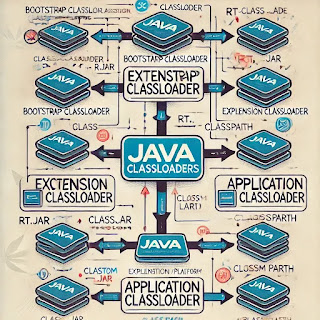Java ClassLoaders Explained
Introduction
In Java, ClassLoaders play a crucial role in dynamically loading classes into the Java Virtual Machine (JVM) during runtime. They are responsible for finding and loading class files when a Java application runs. Understanding how ClassLoaders work is essential for debugging class-related issues and optimizing application performance. In this article, we will dive deep into the different types of ClassLoaders, how they work, and how to customize them.
What is a ClassLoader in Java?
A ClassLoader in Java is a part of the JVM responsible for loading class files (.class) dynamically into memory. It allows Java applications to load classes at runtime, reducing the need to compile everything in advance.
Why are ClassLoaders Needed?
- Dynamic Loading: Java applications can load classes dynamically as needed.
- Memory Optimization: Classes are loaded only when required, reducing memory consumption.
- Customization: Developers can create custom ClassLoaders to load classes from non-standard locations.
Types of Java ClassLoaders
Java provides several built-in ClassLoaders, each with a specific role in the class loading mechanism.
1. Bootstrap ClassLoader
- Parent of all ClassLoaders in Java.
- Loads core Java classes from the
rt.jarorjava.basemodule (since Java 9). - Does not have a Java representation (
nullis returned when you try to get its name). - Loads classes from
java.lang,java.util, etc.
System.out.println(String.class.getClassLoader()); // Output: null (Bootstrap ClassLoader)
2. Extension (Platform) ClassLoader
- Loads classes from the
extdirectory (Java 8 and earlier) or from platform-specific locations (Java 9+). - Loads security and cryptography-related classes.
- A child of the Bootstrap ClassLoader.
System.out.println(javax.crypto.Cipher.class.getClassLoader()); // Output: sun.misc.Launcher$ExtClassLoader
3. Application (System) ClassLoader
- Loads application-specific classes from the classpath (
-cporCLASSPATHenvironment variable). - Loads user-defined classes and libraries.
- A child of the Extension ClassLoader.
System.out.println(ClassLoadersExample.class.getClassLoader()); // Output: sun.misc.Launcher$AppClassLoader
4. Custom ClassLoaders
- Developers can create their own ClassLoaders by extending
ClassLoader. - Useful for loading classes from encrypted files, databases, or network locations.
class MyClassLoader extends ClassLoader {
@Override
public Class<?> loadClass(String name) throws ClassNotFoundException {
System.out.println("Custom ClassLoader loading class: " + name);
return super.loadClass(name);
}
}
public class TestCustomClassLoader {
public static void main(String[] args) throws ClassNotFoundException {
MyClassLoader myLoader = new MyClassLoader();
Class<?> clazz = myLoader.loadClass("java.lang.String");
System.out.println("Loaded class: " + clazz.getName());
}
}
How ClassLoaders Work in Java
1. Delegation Model (Parent-Delegation Model)
The Java ClassLoader follows a parent delegation model to load classes in a hierarchical manner.
How it Works:
- The ClassLoader receives a class loading request.
- It first delegates the request to its parent ClassLoader.
- If the parent ClassLoader cannot find the class, it is passed down to the next ClassLoader in the hierarchy.
- If no ClassLoader can load the class, a
ClassNotFoundExceptionis thrown.
Example of Delegation Model:
public class DelegationExample {
public static void main(String[] args) {
ClassLoader appClassLoader = DelegationExample.class.getClassLoader();
System.out.println("Application ClassLoader: " + appClassLoader);
ClassLoader extClassLoader = appClassLoader.getParent();
System.out.println("Extension ClassLoader: " + extClassLoader);
ClassLoader bootstrapClassLoader = extClassLoader.getParent();
System.out.println("Bootstrap ClassLoader: " + bootstrapClassLoader);
}
}
Output:
Application ClassLoader: sun.misc.Launcher$AppClassLoader
Extension ClassLoader: sun.misc.Launcher$ExtClassLoader
Bootstrap ClassLoader: null
2. Breaking the Delegation Model
Sometimes, we need to bypass the delegation model, such as when:
- Loading custom encrypted classes.
- Implementing plugin-based architectures.
- Avoiding conflicts with existing libraries.
To break the delegation model, we can override the findClass() method in a custom ClassLoader:
class CustomLoader extends ClassLoader {
@Override
public Class<?> findClass(String name) throws ClassNotFoundException {
System.out.println("Loading class: " + name + " using CustomLoader");
return super.findClass(name);
}
}
ClassLoader vs Class.forName()
Many developers get confused between ClassLoader.loadClass() and Class.forName(). Here’s the difference:
| Feature | ClassLoader.loadClass() | Class.forName() |
|---|---|---|
| Delegation Model | Follows delegation model | Loads class explicitly |
| Initialization | Does NOT initialize class | Initializes class (static blocks executed) |
| Usage | Used for dynamic loading | Used when immediate execution is needed |
Example:
ClassLoader loader = ClassLoader.getSystemClassLoader();
Class<?> cls1 = loader.loadClass("MyClass"); // Does not initialize
Class<?> cls2 = Class.forName("MyClass"); // Initializes MyClass
Common Errors and Solutions
1. ClassNotFoundException
- Cause: The requested class file is not found in the classpath.
- Solution: Check if the classpath is correctly set.
2. NoClassDefFoundError
- Cause: The class was compiled successfully but is missing at runtime.
- Solution: Ensure that the required JARs or class files are included in the classpath.
3. SecurityException
- Cause: Custom ClassLoaders may not have permission to load classes.
- Solution: Grant proper security permissions in
java.policy.
Conclusion
Java ClassLoaders are a fundamental part of the JVM, enabling dynamic and flexible class loading. Understanding the delegation model, different types of ClassLoaders, and their customization can help in designing robust applications. Whether you're debugging class loading issues, optimizing performance, or implementing a custom ClassLoader, this knowledge is invaluable for Java developers.
By mastering ClassLoaders, you gain deeper control over Java applications, ensuring better memory management and class organization. 🚀
Sign up here with your email

ConversionConversion EmoticonEmoticon